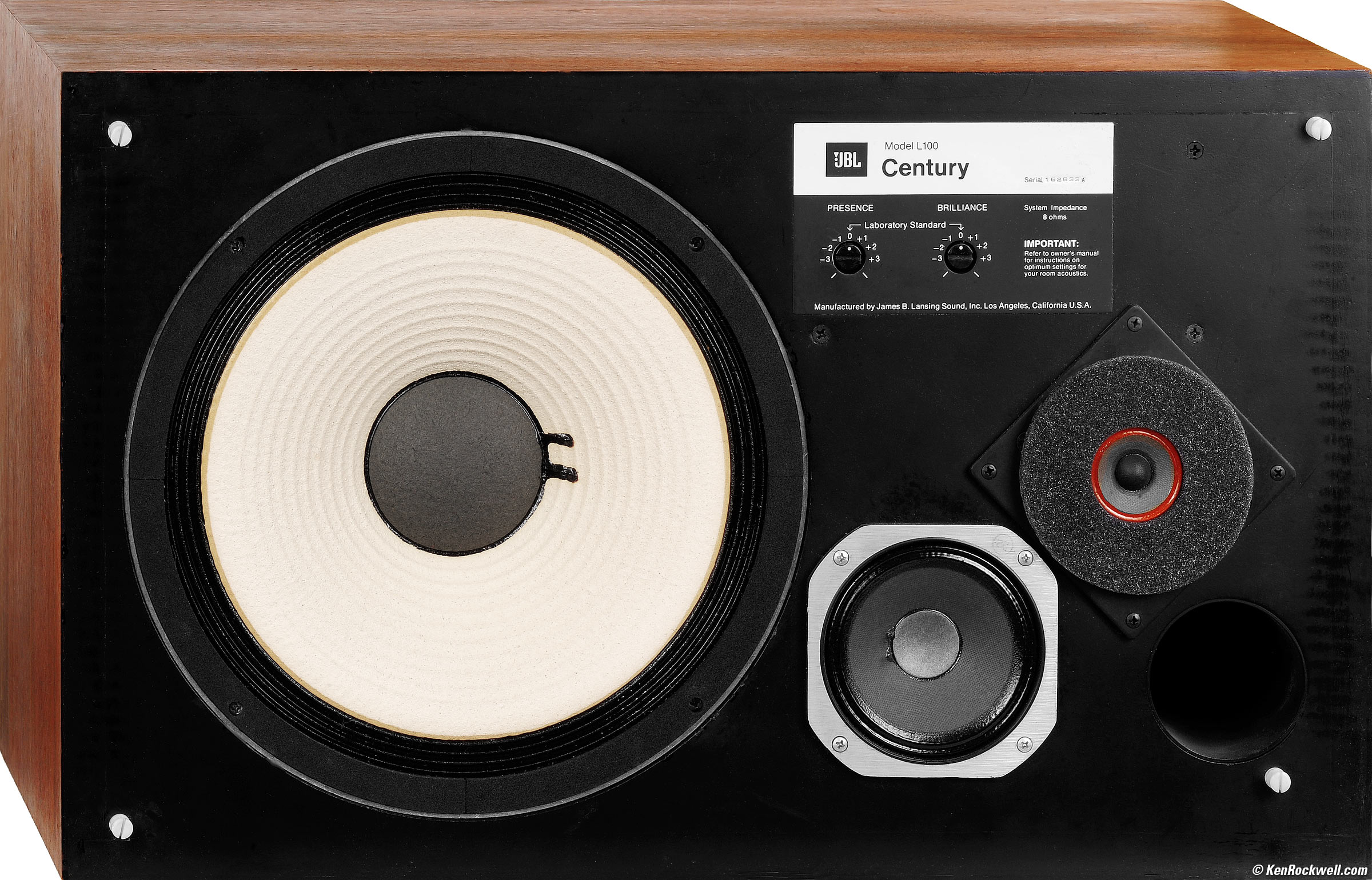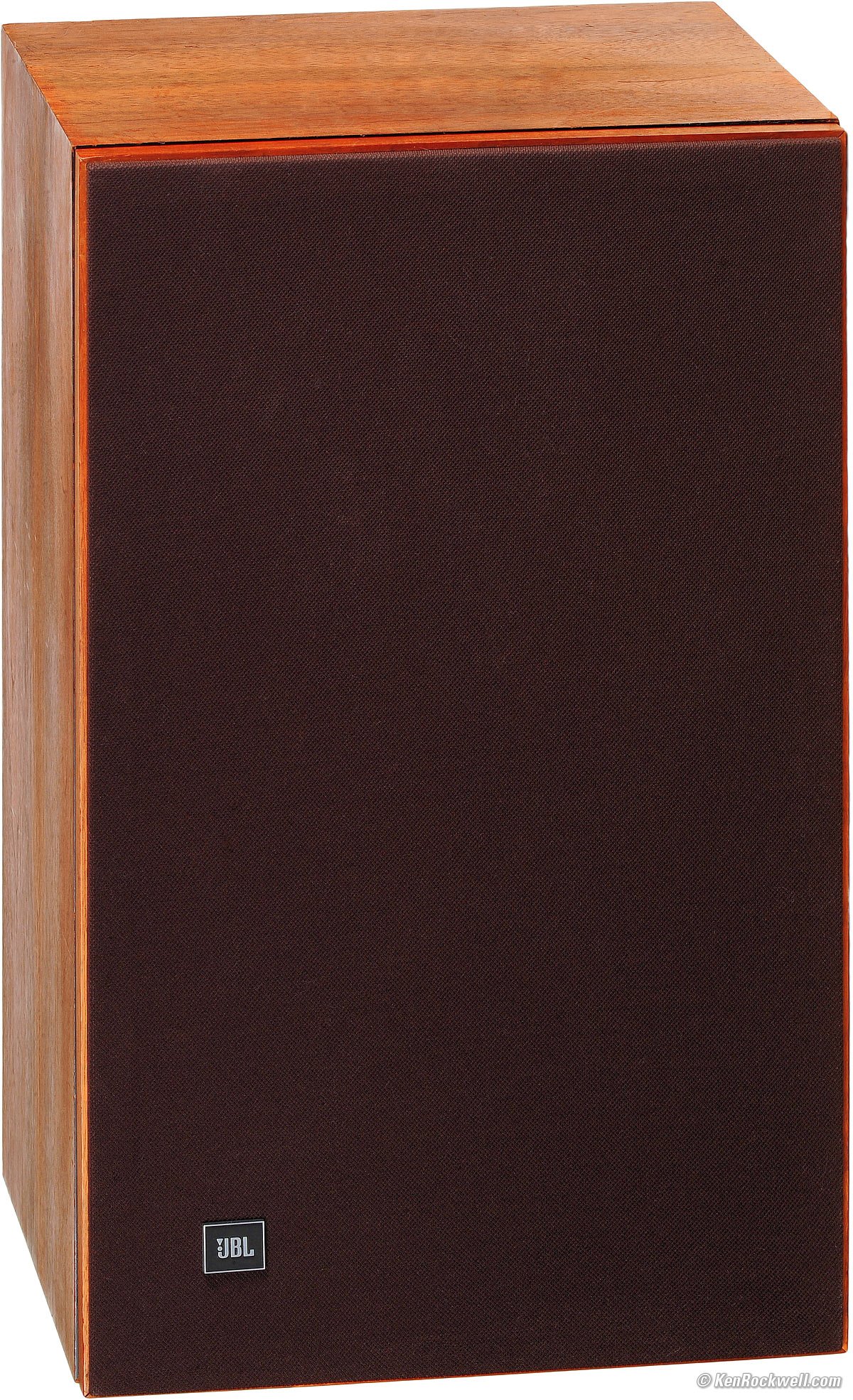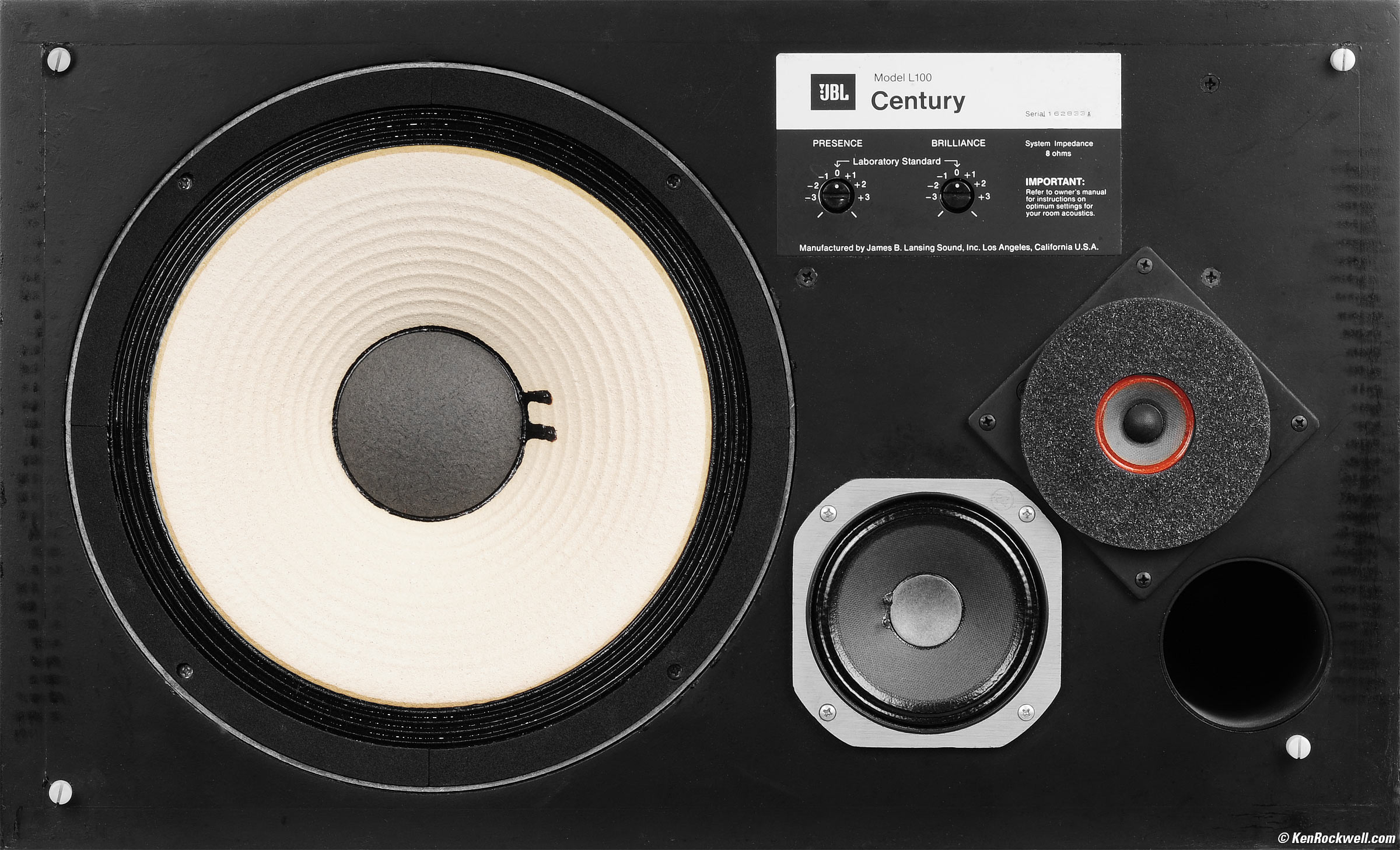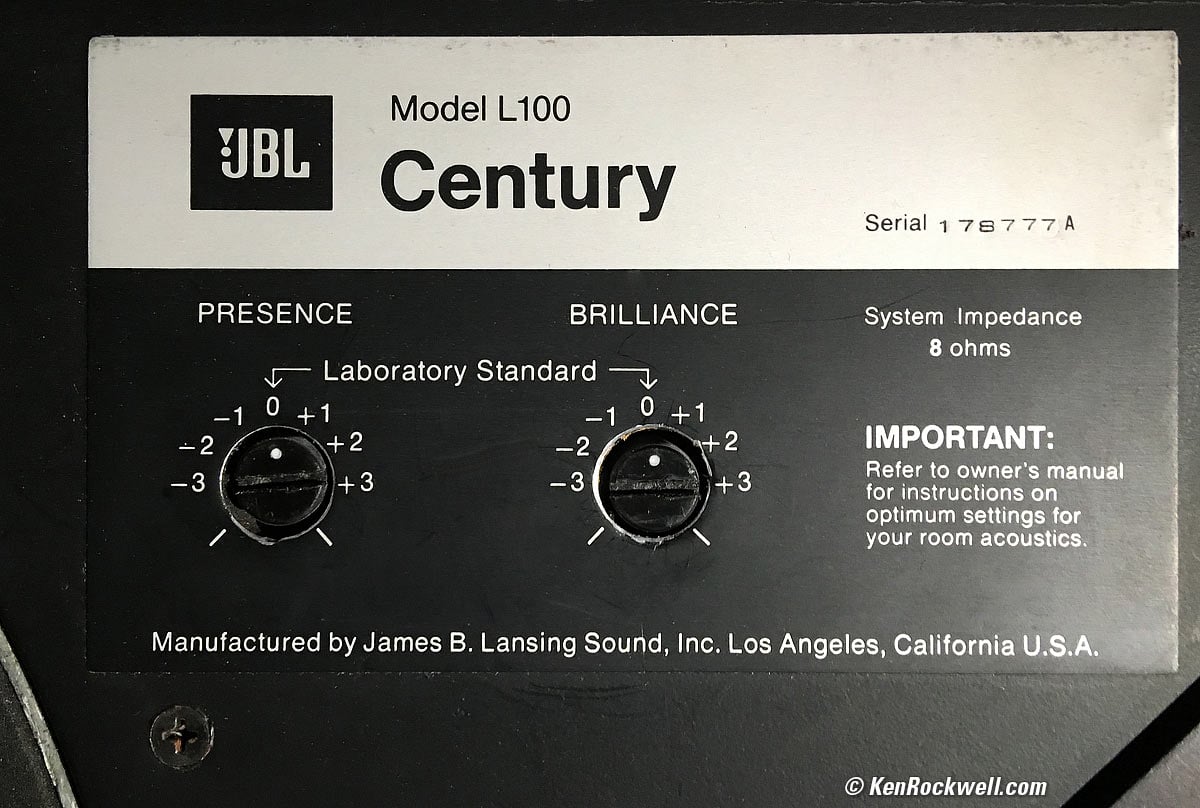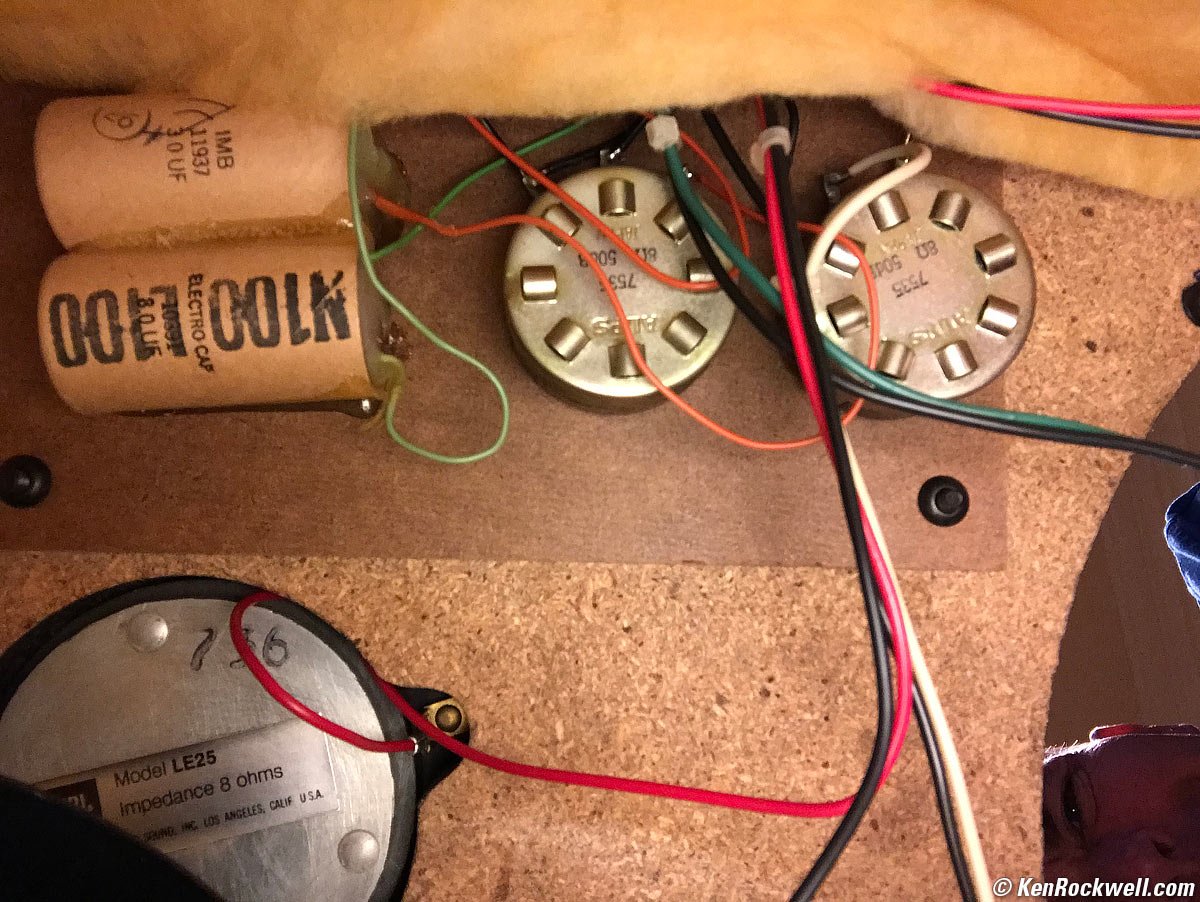JBL L100
King of Rock & Roll (1970-1978)
Introduction Good Bad Specifications
JBL L100 (8Ω, my sample is from 1975, 12" accordion-edge woofer, 5" midrange, 1.4" paper cone tweeter, 45 pounds, 1.6 cu. ft. vented box, 23½ × 14¼ × 13⅝″ WHD, about $1,000/pair used if you know How to Win at eBay, or $2,200 new (each) at Crutchfield.) bigger.
This all-content, junk-free website's biggest source of support is when you use those or any of these links to approved sources when you get anything, regardless of the country in which you live. Thanks for helping me help you! Ken.
November 2021 Audio Reviews Headphone Reviews Tube Amp Reviews All
Introduction top
Introduction Good Bad Specifications
|
I buy only from these approved sources. I can't vouch for ads below. |
The JBL L100 is JBL's, if not the world's, greatest selling speaker of all time. These were everywhere in the 1970s because they sounded great, were small compared to other speakers that sounded this good and played very loud without needing much power. JBL sold a quarter-million of these!
They sold like crazy from their introduction at the 1970 Spring CES in Chicago until they were discontinued in 1978. The only reason they were discontinued is that people finally realized that the professional model 4311 was the same speaker, for less money. People then bought the 4311 like crazy, and even I bought a brand-new pair of 4311 in 1985.
For those of you used to wimpy compact smart speakers that sound "bigger than they are," these astonish young people as these are the "big" speakers that all the little Bluetooth speakers wished they were.
With a full 12" woofer in each speaker, you have stereo bass and none of the distortion that plagues little speakers that try to get "big speaker" sound with electronic fortification — which leads to much more low-frequency distortion.
Two 12" woofers have the same output as one 17" driver (12 × √2 = 17"). Dig it?
The L100 is designed for rock & roll, efficiency, power handling, sine waves and sharp musical transients. Mine love reproducing the solid fundamentals of Genesis' Taurus bass pedals, old & new Eric Clapton, Pink Floyd and everything is deep and punchy. Your favorite classic rock acts were probably recorded with JBL monitors, maybe even these or their 4310 or 4311 brethren.
My 4311 and L100 manuals said that so long as you don't clip your amplifier that you probably will want to leave the room long before the speakers give out from too much power. These are extremely efficient, and they are designed so that the woofer's huge 3" voice coil handles most of the power up to the 1.5 kHz midrange crossover. Tweeter crossover is 6 kHz, keeping a lot of the power in the woofer and not blowing out the other drivers.
They're born for bookshelf, wall and soffit mounting, coming from the pro 4310 Studio monitor of 1968 that was intended for soffit or wall mounting. Don't waste your time with stands in the middle of the room.
You can drive these with anything due to their high efficiency. A Crown D-75 was and is perfect; they need little power to become deafening. I only drive my American speakers with American-made Crown electronics like we used in the studios back in the day of passive speakers.
The loudness contour of the Crown Straight Line Two is perfect for boosting the deepest bass. Find the right spot for these speakers and drive them with these classic electronics and you can feel what all the crappy little imported stereos and smart speakers of today are trying to imitate.
While 1970s L100s are awesome rock speakers and were often used as monitors in the studios where our favorite classic rock was recorded, they never sounded great for serious classical music listening. They always sounded like the music was coming out of a box from paper drivers, which these are.
I was in middle school in the mid 1970s when L100s ruled the world. Our band, orchestra and choir rehearsal rooms (and music appreciation classes) all had L100s mounted 40 feet apart on opposites sides above or below the huge blackboards. When teachers played something through whatever crappy Lafayette solid state amp was on hand it always sounded great. One time our band teacher played us the Frederick Fennel (good) version of whatever he was trying to get us to play, and we were all simply sat stunned in silence. What the heck was that? Could humans actually play this piece that well? Holy cow! It was unbelievable, and all we heard was the music, not the speakers.
Expensive speakers aren't; unlike electronics and digital cameras that go obsolete every few years, speakers last a lifetime. I'm still using my original L100s; mine came with cloth grills and none of these use foam in the drivers so the 1970s L100 drivers should last forever so long as no one has damaged them. (I did replace my foam tweeter rings; I doubt they actually improve the sound as originally claimed.)
My B&W 801 from 1983 play like new; the speakers you buy today are a very long-term investment over which your kids will be fighting when you pass on to the great concert hall in the sky. As you can see at eBay, used 1970s L100s sell for more today than the sold for new!
JBL L100. bigger.
New 2018 version
The most classic speaker of all time comes back!
JBL reintroduced these classic 3-way 12" vented speakers in 2018. They use an all-new design with different drivers and (thank goodness) a new crossover, so they should sound way better than the originals, while retaining the look of the original, down to the crazy cubical foam grilles.
The originals used woofers with pleated cloth surrounds, paper cone tweeters and a primitive crossover that consisted of only two capacitors and two L-pads, period. All the technology was in the drivers, certainly not the cosmetics or crossovers!
The new L100s try to fix that with an internal brace to stop the box from sounding like a box, and using modern drivers — not paper-cone tweeters!
The new L100s have the same 5-year warranty as the originals.
I haven't heard the new versions yet so can't speak to them precisely, however the new versions should sound much, much better, and as a full-sized speaker should sound worlds better than smaller speakers, especially if you're used to needing subwoofers which screw up the music by sending different parts of it to different places in your room. With real speakers, all the music comes from the same place without being chopped up before it even gets out into your room.
The new ones, as full size speakers, should astonish anyone used to using dinky little 2-way 8" speakers with the crutch of a single subwoofer.
The L100s are sold today as single speakers; get two for stereo, four for quad and five for movies.
Much better than neighborhood stereo stores in the 1970s, today (and also back in the 1970s when they first opened) Crutchfield gives us 60 days to enjoy our speakers in our own home or studio with our own music and electronics, and if we don't love them, no big deal, just send them back for a full refund. This sure beats wasting time in a stereo store wondering how they'll sound back at home — and we don't have retail stereo stores in 2021 anyway.
Good intro top
 Full-range punchy sound perfect for rockin' the house.
Full-range punchy sound perfect for rockin' the house.
 Plays loud without much power.
Plays loud without much power.
 Full bass response, no stinking subwoofers needed.
Full bass response, no stinking subwoofers needed.
 Full-sized sound from a compact speaker.
Full-sized sound from a compact speaker.
 Front-panel midrange and tweeter controls to let you fine-tune these to your room and taste.
Front-panel midrange and tweeter controls to let you fine-tune these to your room and taste.
 Made in the United States of America.
Made in the United States of America.
Bad intro top
 For classical music these sound like paper drivers in a wooden box, which they are. While JBL worries about lack of power compression and flat on-axis sine-wave response, they completely ignore the effects of what happens to the half of the sound that goes into the box and comes back out through the lightweight cones that give them such high efficiency. Use these for rock and pop, but pass for symphonic and choral music.
For classical music these sound like paper drivers in a wooden box, which they are. While JBL worries about lack of power compression and flat on-axis sine-wave response, they completely ignore the effects of what happens to the half of the sound that goes into the box and comes back out through the lightweight cones that give them such high efficiency. Use these for rock and pop, but pass for symphonic and choral music.
 Original 1970s samples that haven't been destroyed by hobbyists "modding" them are very hard to find.
Original 1970s samples that haven't been destroyed by hobbyists "modding" them are very hard to find.
 New ones are expensive and made overseas.
New ones are expensive and made overseas.
Specifications (1970s version) top
Introduction Good Bad Specifications
JBL L100. bigger.
System Impedance specifications top
8Ω.
Sensitivity specifications top
91 dB SPL at 1 meter with 1 watt (2.83V) input.
(JBL rates it as 78 dB SPL at 1 watt input at 15 feet, same as 91 dB at 1 meter).
Optimum Rated Amplifier Power specifications top
10 watts to 150 watts.
Rated Power Capacity specifications top
50 watts program.
That means a long-term RMS average of 50 watts wideband, more or less. They never really came clean on explaining this one, mostly pointing out correctly that these will easily play far louder than you would ever want them to.
Cabinet specifications top
3/4" particle board.
No internal bracing.
Oiled American black walnut veneer (grill frames are solid American black walnut).
The port has a 90º bend at the back to fit in a box this shallow. It also means you don't see the insides of the speaker through it.
Foam grills came in Burnt Orange, Ultra Blue or Chocolate Brown.
Drivers specifications top
The genius and expense of the L100 are in its drivers, all of which are designed and made in-house by JBL in Northridge, California.
12" Woofer 123A-1
8Ω.
4.5 - 5.5Ω DC.
310mm (12.20") measured basket diameter.
255mm (10.04") measured effective piston diameter
3" edge-wound copper ribbon voice coil gives a higher copper-to-air ratio than using regular round wire.
6.75 pound Alnico V magnet.
1.04 Tesla (10,400 Gauss) flux density across 0.045" gap. Gap made to 0.0005" precision.
92 dB SPL at 1 meter with 1 watt (2.83V) input, 100~500 Hz warble.
27 Hz free-air resonance.
Box tuning (minimum cone motion and impedance) is at about 30 Hz.
Same accordion edge as JBL's newest state-of-the-art $25,000 M2 monitors.
Cast aluminum frame.
Shallow cone designed to have good dispersion even at the 1,500 Hz crossover frequency.
The white stuff is the "Aquaplas" or "Lansingplas" damping material claimed to keep reverberations from bouncing around inside the cone material, but tapping the cone makes it ring like a bell so I'm unsure how much this is effective rather than cosmetic.
5" Midrange LE5-2
8Ω.
5.5 - 6.5Ω DC.
7/8" voice coil.
2.75 pound Alnico V magnet.
1.65 Tesla (16,500 Gauss) flux density across 0.040" gap.
Inverted (concave) dust cap.
96 dB SPL at 1 meter with 1 watt (2.83V) input, EIA.
1.4" Tweeter LE-25
8Ω.
3.7 - 4.2Ω DC.
5/8" voice coil.
1.6 pound magnet.
1.5 Tesla (15,000 Gauss) flux density across 0.029" gap.
97 dB SPL at 1 meter with 1 watt (2.83V) input, averaged above 2 kHz.
Impregnated cloth suspension.
Foam surround claimed to eliminate unwanted reflections and radiations, but looks and sounds more cosmetic to me.
Crossover specifications top
Frequencies
1,500 and 6,000 Hz.
Design
It's two capacitors, two L-pads, and that's it.
The woofer is driven full-range. There is no high-frequency cutoff.
The midrange has an 8 µF series capacitor and an L-pad, and like the woofer, no high-frequency cutoff!
The tweeter has a 3 µF series capacitor and an L-pad, and you're done.
It can't get simpler than this! As I said, the brilliance is in the drivers and definitely not the crossover or cabinet.
1975 JBL L100 Century Crossover Controls. bigger.
1975 JBL L100 Century Crossover Components - all two capacitors and two L-pads! bigger.
Size specifications top
23½ × 14¼ × 13⅝″ WHD placed horizontally (HWD placed vertically).
597 × 362 × 364mm WHD placed horizontally (HWD placed vertically).
Weight specifications top
45 pounds each.
55 pounds as shipped.
Quality specifications top
Made in U. S. A.
New version made in China or Indonesia.
Date Code specifications top
None on the speaker, but the L-pads in the crossover usually have a four-digit YYWW (year/week) date code. The speakers would have been made some weeks or months after the L-pads were made.
Price, U. S. A. specifications top
November 2021
About $1,000/pair used if you know How to Win at eBay.
$2,200 new (each), new version not tested here.
1970
$273 each.
Recommendations top
Introduction Good Bad Specifications
Like all popular consumer products, JBL made many minor modifications to it over the years to keep it looking fresh and encouraging people to buy the "new version" which was 95% the same as the previous one. Don't sweat driver alignment or A versus non-A models; they're all 95% the same L100.
Most of these are seen with whacky cubical foam grills. 1970s foam has all fallen apart today and people sell replacements. Mine came with cloth grills that have survived, in fact they are so nice that they have two layers of cloth a half inch (1 cm) apart to ensure that you never see the drivers through the grill so your house looks like a home and not a science lab.
Don't waste your time modifying these attempting to "improve" them. No matter what you do they are still paper cones in an empty and mostly undamped wooden box. Their simple crossovers are part of the sound. These are not modern Genelec or B&W monitors with rock-solid drivers and cabinets that eliminate internal sound leakage, stored energy, resonance and re-radiation, so don't waste your time trying to get them to sound totally neutral.
After decades of abuse, my 1975 walnut veneer perked right up with a simple wipe of a paper towel with Howard Products Restor-a-finish as shown in these photos. It should look even better when I polish it with Howard Products Feed-N-Wax next.
If your midrange or tweeter is either distorted or not working, it's probably a dirty level control. Rotate its front-panel control back and forth several times and this may cure it.
If you're playing records, you probably want to use the Rumble or Subsonic filter in your preamp to keep record warps and turntable rumble from making the woofer wander in and out. While the acoustic suspension (sealed) speakers popular in the 1970s didn't have this problem because their woofer cones were held in place at subsonic frequencies by the air in the sealed box, vented (open-box) speakers like these will have a load of cone motion if driven by frequencies below box resonance, which is about 30Hz in the L100.
The woofer shouldn't wobble while playing; if you can see it moving (rather than vibrating) then that can lead to harmonic or intermodulaiton distortion as the cone moves away from its rest position.
JBL varied from year to year as to the polarity of their speakers. Positive voltage at the red terminal may make your woofer go out or in, so know this if you're trying to integrate these in a larger system. Today's speakers have the cone move out with positive voltage at the red terminal.
Back in the 1970s many people settled for less expensive "mid-fi" amplifiers made overseas by Pioneer, Sony, Lafayette, Marantz and others, while serious music lovers spent much more for serious American amplifiers like McIntosh, Crown, Hafler, Apt, Adcom and many others. In the studios we always ran these with Crown amplifiers. Today I'd use nothing other than a classic American amp (or Bryston) to drive these; there's no reason to waste time with lesser amps today since used American classics are almost free.
This all-content, junk-free website's biggest source of support is when you use those or any of these links to approved sources when you get anything, regardless of the country in which you live. Thanks for helping me help you! Ken.
Thanks for helping me help you!
Ken.
More Information top
Introduction Good Bad Specifications
Lansing Heritage L100 history page.
Lansing Heritage's 1973 L100 flyer.
© Ken Rockwell. All rights reserved. Tous droits réservés. Alle Rechte vorbehalten. Ken Rockwell® is a registered trademark.
Help Me Help You top
I support my growing family through this website, as crazy as it might seem.
The biggest help is when you use any of these links when you get anything. It costs you nothing, and is this site's, and thus my family's, biggest source of support. These places always have the best prices and service, which is why I've used them since before this website existed. I recommend them all personally.
If you find this page as helpful as a book you might have had to buy or a workshop you may have had to take, feel free to help me continue helping everyone.
If you've gotten your gear through one of my links or helped otherwise, you're family. It's great people like you who allow me to keep adding to this site full-time. Thanks!
If you haven't helped yet, please do, and consider helping me with a gift of $5.00.
As this page is copyrighted and formally registered, it is unlawful to make copies, especially in the form of printouts for personal use. If you wish to make a printout for personal use, you are granted one-time permission only if you PayPal me $5.00 per printout or part thereof. Thank you!
Thanks for reading!
Ken.
